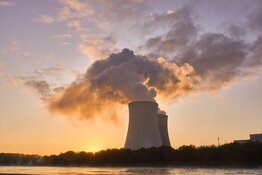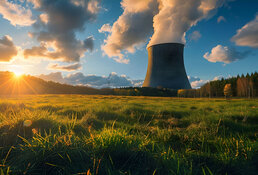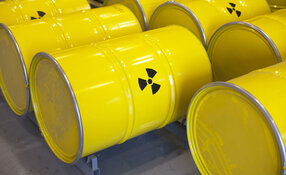NANO Nuclear Energy Inc. (NNE:NASDAQ) has been selected as one of 16 civil nuclear entities to join the U.S. Department of Commerce's International Trade Administration's Civil Nuclear/SMR Industry Working Group for Southeast Asia. This initiative is aimed at supporting the deployment and export of U.S. small modular reactors (SMRs) and advanced nuclear technologies to the Southeast Asian region.
The working group operates under the U.S. Department of Commerce and its interagency SMR Public-Private Program. It aims to promote the deployment of advanced nuclear technologies while adhering to rigorous safety, security, and nonproliferation standards. The group will meet quarterly to review policies, government activities, and export opportunities related to SMRs and advanced nuclear technologies. Participating members, including NANO Nuclear, will receive targeted briefings on energy demand and updates about U.S. government initiatives such as trade missions and industry roundtables.
Jay Yu, Founder and Chairman of NANO Nuclear Energy, noted the strategic importance of this collaboration, stating in the news release, "Southeast Asia presents a very promising market for our advanced, portable microreactor power solutions in development. The region's geographical challenges often limit the expansion of traditional power grids, leading many communities to rely on diesel generators. NANO Nuclear's involvement in this working group will allow us to gain deeper insights and adapt our proprietary microreactors to meet the specific needs of Southeast Asian communities as well as remote areas generally, which has always been a part of our strategy. We're eager to contribute to the region's transition to carbon-neutral, secure, and portable nuclear energy solutions."
James Walker, CEO and Head of Reactor Development, emphasized the opportunity to strengthen relationships with stakeholders in Southeast Asia, particularly in the Philippines, and with U.S. officials. Walker added, "Our portable microreactor solutions have the potential to greatly enhance quality of life and industry in the region."
In addition, on November 6, NANO Nuclear Energy announced a US$2 million investment in LIS Technologies Inc. (LIST), a U.S.-origin developer of patented laser-based uranium enrichment technology, as part of LIST's oversubscribed US$11.88 million seed financing round. The collaboration includes a strategic agreement under which LIST will provide enriched uranium hexafluoride (UF6) fuel for NANO Nuclear's microreactors and future third-party sales.
NANO Nuclear Energy received a target price increase of 69% from US$39 to US$66 per share, according to a November 7 research report by Benchmark Co. analyst Michael Legg.
NANO Nuclear will also develop deconversion and fuel fabrication facilities to support LIST's enriched UF6 integration into the broader nuclear fuel supply chain. The collaboration aims to enhance domestic uranium enrichment capabilities and address growing demand for HALEU fuel. This fuel is critical for advanced nuclear technologies like NANO Nuclear's ZEUS and ODIN microreactors.
Jay Yu, Founder and Chairman of NANO Nuclear, described the partnership as a competitive advantage, stating in the news release, "The technology being developed by LIST has the potential to reshape the United States' uranium enrichment capabilities and pave the way for the next generation of advanced nuclear reactors." James Walker, CEO of NANO Nuclear, emphasized the importance of this agreement in securing a reliable fuel supply and enabling broader business opportunities within the nuclear energy marketplace.
The State of Nuclear Energy
The Department of Energy (DOE) reported on November 12 that new federal frameworks have been established to achieve nuclear deployment targets of 35 gigawatts by 2035 and 15 gigawatts annually by 2040. These frameworks align with pledges made at previous climate summits to triple global nuclear capacity by 2050. The DOE emphasized the importance of new technologies, such as small modular reactors and micro reactors, in meeting these goals.
"Nuclear energy is the nation's largest source of clean power and avoids more than 470 million metric tons of carbon dioxide emissions each year," the DOE reported, adding that existing nuclear sites and retired reactor sites could host up to 95 gigawatts of additional capacity when small modular reactors are included. Federal incentives under the Bipartisan Infrastructure Law and the Inflation Reduction Act have helped jumpstart these efforts, with advanced reactor demonstrations and HALEU fuel availability being key priorities.
According to The New York Times, on November 15, 22 countries committed to tripling global nuclear capacity by midcentury at last year's COP28, with six additional countries joining this pledge during COP29 in Azerbaijan.
Dr. Sama Bilbao y Leon of the World Nuclear Association highlighted this shift, noting that nuclear power has evolved from being dismissed at climate talks to being recognized as a viable solution. "A lot more people are open to talking about nuclear power as a solution," she said, with countries like Kenya and Mongolia now planning to adopt nuclear technologies alongside established users such as the United States and France.
On the same day, Reason.com detailed the Biden administration's ambitious plan to triple nuclear power capacity in the U.S. by 2050. The strategy aimed to bring 200 gigawatts of new capacity online, including 35 gigawatts by 2035. While initiatives such as tax credits and federal financing have supported these goals, regulatory reforms remain critical. Current guidelines, such as the ALARA standard for radiation levels, significantly inflate project costs and timelines.
"By demanding that nuclear power plants emit as little radiation as possible, federal regulators communicate to the public that any level of radiation is dangerous," the article noted. The Accelerating Deployment of Versatile, Advanced Nuclear for Clean Energy Act, signed earlier this year, began addressing these regulatory challenges.
The Catalysts Behind NANO
NANO Nuclear Energy's participation in the Civil Nuclear/SMR Industry Working Group builds on its broader strategy of innovating within the nuclear energy sector.
According to the company's investor presentation, its advanced technologies, including proprietary microreactors like ZEUS and ODIN, are being developed to address global energy challenges. These reactors are designed to provide clean, portable power solutions tailored for remote and underserved regions.
The company's involvement in the Southeast Asia working group complements its planned development of High-Assay Low-Enriched Uranium (HALEU) fuel and transportation infrastructure. These efforts are expected to support both domestic and international advanced nuclear projects.
Additionally, NANO Nuclear is working on the commercialization of its reactor designs, with anticipated milestones including the construction of a manufacturing facility and further prototype testing by 2026. Its HALEU fuel fabrication facility, planned near Idaho National Laboratory, is projected to enhance the company's capability to serve advanced reactor companies and U.S. energy initiatives.
By participating in initiatives like the Civil Nuclear/SMR Industry Working Group and advancing its technology pipeline, NANO Nuclear aims to position itself as a key player in the global transition to sustainable energy solutions.
An Analysis of NANO Nuclear Energy
NANO Nuclear Energy received a target price increase of 69% from US$39 to US$66 per share, according to a November 7 research report by Benchmark Co. analyst Michael Legg. The adjustment reflected the company's "robust internal development" and strengthened financial position, with US$65 million in cash and no debt.
"NANO Nuclear's balance sheet has been bolstered by capital raises placing over US$65 million on [the] balance sheet, allowing [the company] to continue to execute on its strategy," Legg noted. With the company trading at approximately US$19.05 per share at the time of the report, this target price implied a potential 246% return.
Legg highlighted key milestones in NANO Nuclear's progress, including the advancement of its ZEUS and ODIN small modular reactors (SMRs) to the physical test work phase and initial rig construction. The company also expanded its team, appointing notable leaders such as former U.S. Department of Energy Chief Financial Officer John Vonglis and Lieutenant General Terry G. Robling, USMC (Ret.), to its advisory boards. Additional progress included acquiring a 14,000-square-foot facility in Oak Ridge, Tennessee, for its Nuclear Technology Center and initiating pre-application reviews with the Nuclear Regulatory Commission (NRC).
The report emphasized growing demand for nuclear power in sectors such as artificial intelligence data centers, bitcoin mining, and electric vehicles, all benefiting NANO Nuclear's business outlook. "We believe this passing is further justification that nuclear is needed to reach climate initiatives, as nuclear is the only large-scale, reliable, emission-free energy source," Legg wrote, referring to the recently passed ADVANCE Act aimed at accelerating advanced nuclear technology development.
 Streetwise Ownership Overview*
Streetwise Ownership Overview*
NANO Nuclear Energy Inc. (NNE:NASDAQ)
NANO Nuclear remained a Buy, with Legg projecting ongoing operational success and increasing market awareness of SMRs as potential catalysts for share price appreciation.
Ownership and Share Structure
According to NANO Nuclear Energy's latest filings, NANO Nuclear Energy Inc. had a market capitalization of approximately US$778 million, with 33.7 million shares outstanding and a public float of 20 million shares, as of November 19, 2024. The stock's 52-week range was between US$3.25 and US$37.51 per share.
Management and insiders held 38.20% of the company's shares. The remaining shares were held by retail and increasing institutional investors.
NANO Nuclear went public in May 8 2024, becoming the first publicly listed company focused on vertical integration, while developing and designing portable nuclear microreactors. In just over six months since its US$4.00 initial public offering, the stock has risen 467% as of November 18, 2024 close at US$22.69, making NNE the number 1 IPO gainer of 2024.
| Want to be the first to know about interesting Uranium investment ideas? Sign up to receive the FREE Streetwise Reports' newsletter. | Subscribe |
Important Disclosures:
1) James Guttman wrote this article for Streetwise Reports LLC and provides services to Streetwise Reports as an employee.
2) This article does not constitute investment advice and is not a solicitation for any investment. Streetwise Reports does not render general or specific investment advice and the information on Streetwise Reports should not be considered a recommendation to buy or sell any security. Each reader is encouraged to consult with his or her personal financial adviser and perform their own comprehensive investment research. By opening this page, each reader accepts and agrees to Streetwise Reports' terms of use and full legal disclaimer. Streetwise Reports does not endorse or recommend the business, products, services or securities of any company.
For additional disclosures, please click here.









































